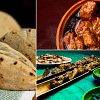Why Lal Miya’s kotkoti is the heart of Bogura’s flavourful legacy

If you ever visit Mahasthangarh in Mahasthan, Bogura, you will pass through the area of Shah Sultan Balkhi Mahisawar Mazar. The moment you arrive at the gate; your eyes will catch rows of shops selling one special treat that instantly draws attention: kotkoti! Among all these shops, you will instantly recognise the pioneer, one that witnessed Mahasthan's rise to a tourist hotspot: Lal Miya Kotkoti Ghar.
Behind the counter of this famous shop sits a man whose story is carved into the history of this place, Lal Miya, still reigning over it at more than 90 years old. When we met him, he smiled softly and invited us to sit and listen to his life story, a tale that began more than a century ago.

Lal Miya's grandfather, Jahar Mahmud, was the first to start selling sweets near the mazar gate.
Back then, there were no crowds, no bustling market, only open land and the fear of wild animals.
"In those days," Lal Miya shares, "there were tigers that roamed around here freely."
Jahar Mahmud used to sell simple sweets like khagrai and batasha inside a small straw hut he built, a nameless little shop. Visitors to the mazar would often buy a little amount of sweets as 'shinni,' a traditional offering distributed at the conclusion of religious gatherings.
After his death, his son Mohammad Ali took over the family trade. Business was slow, and survival was a challenge. To revive it, he decided to try something new. Alongside khagrai and batasha, he experimented with flour and jaggery, frying the mixture in mustard oil to create a hard, crunchy sweet that made a sound when bitten. And thus, "kotkoti" was born. Over time, both the process and the taste evolved, yet the business continued to face difficulties.
It was around 1940 when Lal Miya, Mohammad Ali's son, took over the family business. Mahasthan was still quiet and undeveloped.

"There were only a few shops here then when I started," he explains.
Lal Miya brought changes to the recipe, and it was an instant hit. He replaced wheat flour with rice flour, and instead of mustard oil, he began using palm and soybean oil. He even added a mix of spices to make the flavour richer. The results were immediate — kotkoti became tastier and more popular than ever before.
By the 1980s, Lal Miya replaced the old straw hut with a tin-roofed shop and put up a signboard that said "Lal Miya Kotkoti Ghar."
Business started to flourish, and soon, workers and local vendors began learning from him, setting up their own small shops nearby. Thus, Mahasthan gradually turned into a kotkoti hub, where dozens of families make their living from this simple, crunchy sweet now.
While talking to Lal Miya, we also met his sons and grandsons, who now look after the shop. Interestingly, every few minutes, customers came in, and before anyone bought anything, they were first offered a few pieces to taste.
Curious, we asked one of the sons why they did this. He smiled and said, "Feeding someone is 'ibadah' — a pious act. This is what our father and grandfather taught us. You may or may not buy from our shop; it doesn't matter. If you come to our shop, you will taste free kotkotis, whoever you are."
And in that moment, we instantly realised that it was this simple, generous spirit that made Lal Miya's kotkoti truly special.

We were offered some as well. The warm kotkotis were coated with jaggery but not overly sweet, carrying the rich aroma of ghee with subtle hints of black cumin and bay leaves. Each bite was satisfyingly crunchy, releasing the nutty, caramelised flavours of the fried dough.
Today, Mahasthan is a busy place. Every Friday, hundreds of visitors walk through the ancient ruins of Mahasthangarh, and almost every one of them stops by the kotkoti shops before heading home.
"On Fridays, we sell around 20-25 maunds," Lal Miya shares. "And, on weekdays, maybe 10-12 maunds, and that's fine too."

There are five types of kotkoti now at Lal Miya's shop: fried in oil, dalda, ghee, premium ghee, and shahi. They differ in ingredients: the shahi variety, for example, is enriched with assorted nuts. Prices range from Tk 160 to Tk 300 per kilogram.
The popularity of kotkoti has grown far beyond Bogura. Visitors take it home as gifts, and some even send it abroad. Over the years, other shops have risen, each adding its own flavour to the tradition. But for most locals, the name Lal Miya's kotkoti still carries a nostalgic weight, the taste of time itself.
"I am old now," Lal Miya expresses, "but when I see my sons continue to serve the people, it brings a warmth to my heart I cannot describe."

 For all latest news, follow The Daily Star's Google News channel.
For all latest news, follow The Daily Star's Google News channel. 







Comments